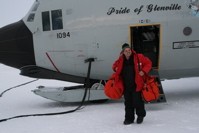NBC 6
March 9, 2007
By Julia Yarbough
Antarctica, the frozen icy landscape that seems a world away, is actually closer than you might think thanks to a South Florida artist with vision and talent.

Even if you don’t know the name, you may have seen Xavier Cortada’s Eco-Art strategically located at points in and around Miami-Dade. This artist just returned from a trip of a lifetime to Antarctica.
“Antarctica is a continent that helps us reflect on our humanity because it is the only place on Earth that hasn’t been tapped. 90% of our planet’s fresh water is in the ice sheet that blankets that continent. Scientists from all over the world are in that continent researching the effects of our actions and how we adversely impact that sheet of ice. As that ice melts; we all die.”
Cortada, the recipient of a National Science Foundation grant in December made the incredible journey to Antarctica to do what he does best. Create art that makes us think. It was an exhausting trip. Five hours to Los Angeles, fourteen and half hours to Australia, two more hours to New Zealand, five hours to the famed McMurdo Research Station then finally another three hours to the South Pole, where temperatures hovered around -20 degrees during his visit.
Cortada says being in a place so pristine, so untouched by man inspired him.
“We are just custodians taking care of this planet. Human history is just a blink of an eye and we need to be more aware of our consequences of our actions on the planet.”
The creative action Cortada chose to take was to install artistic pieces to signify how all of us all over the globe are connected and responsible for our plane
In The Longitudinal Installation, Cortada placed twenty-four shoes in a circle around the South Pole. They are only inches apart but signify how people around the world who live miles apart are actually closer than they might think, because their communities lie on the same longitudinal line.
“There are no boundaries, says Cortada.
In Endangered World, Cortada place twenty flags around the pole and on each flag included the name of an endangered species and the longitude of that animal’s habitat.
“If we don’t do anything about global warming, then we will lose many of the species which now exists.”
In The Markers, Cortada placed fifty-one different flags on the main sheet of ice that covers the South Pole; ten miles apart. Each indicates where the Pole stood over the past fifty years.
“It captures how time moves. And most significant is that it was literally fifty years to the day that the South Pole station was opened, January 4th, 1957, that I positioned the flags. It’s a way to celebrate the fiftieth anniversary of research in the South Pole. Every flag stands where a contributing scientist once stood.”
A little piece of South Florida also stayed behind when Cortada returned. He placed a Mangrove seedling in the ever-moving ice. Theoretically it should take one hundred fifty thousand years for that seedling to reach the coastline and put down roots.
Cortada says his trip allowed him to blend science with art in a unique way. His exhibit will also feature a series of Ice Paintings. Scientist in the South Pole gave him samples of their work. Ice. Volcanic ash and rocks. Pieces of dirt millions of years old.
“These are all guys telling me that science of Antarctica by showing me their work. With the same materials, I am using art to expand knowledge.”
To see Xavier Cortada’s latest exhibit and visit Antarctica without ever leaving South Florida, simply head on over to the Kunsthaus Contemporary Art Space, at 3312 North Miami Avenue, Miami, Florida, 33127 in the Wynwood Art District.
The exhibit opens Saturday, March 10th and runs through May 5th.
Copyright 2007 by NBC6.net. All rights reserved.
This material may not be published, broadcast, rewritten or redistributed.
